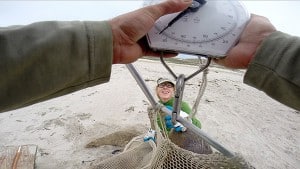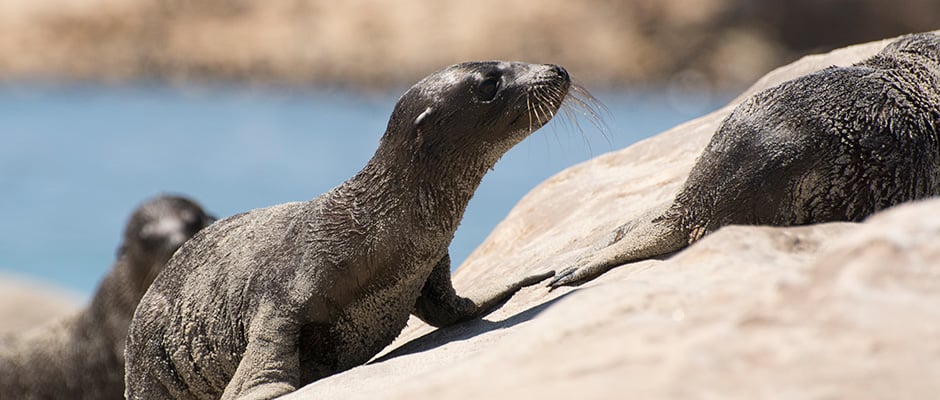Share this article
A Deeper Look at Record Sea Lion Pup Strandings
The California Stranding Network started getting calls at the very beginning of the year. California Sea lion pups (Zalophus californianus) — sometimes three or four in one area in a day — started turning up on the beaches. Staff with the National Marine Fisheries Service worked to gather the pups and by February, many of the seven rehabilitation centers throughout California were mostly full of the noisy and undernourished pups.
“We had days that were super busy,” said Justin Viezbicke, coordinator of the California Stranding Network.
While the last few years have all seen a significant spike in hungry sea lion pups that end up stranded on shore, this year could have the highest number yet taken in by facilities at nearly 3,000 pups so far this year.
And Viezbicke said that this number doesn’t reflect the full amount of stranded pups as others may have died on the beach before wildlife officials could help them.
Sharon Melin, a wildlife biologist with the National Marine Mammal Laboratory of the National Oceanic and Atmospheric Administration, said that many of the pups probably came from San Miguel Island, which hosts one of the largest populations of California sea lions. Melin and other biologists have been tracking marine mammals on the island — uninhabited today except for a research center — since the early 1970s and have a long-term series of data “that tells us when things are not going as they should.”
California sea lions, along with all other marine mammals in the U.S., were listed as protected under the Marine Mammal Protection Act of 1972. Sea lion populations declined drastically in the early 19th century because of over-exploitation over the previous centuries, but have rebounded since then. In fact, while there were an estimated 30,000-50,000 sea lions around the time the MMPA was instituted, today, the population off the coast of the United States alone numbers around 300,000 animals without counting others off Mexico’s Baja California.
But Melin said that current strandings could reflect the changes in ocean currents and ocean productivity due to climate change. “If there are any kind of environmental changes that go on in the year, it can impact the pup,” Melin said, adding that cyclic weather patterns such as el Niño and La Niña can affect rises and falls in populations.
“It’s been a series of really dramatic conditions that have resulted in very low survival of pups.”
Pups are dependent on their mothers’ milk for around 11 months a year, fasting when the mothers are out foraging in the ocean.
But these days, sea lion prey including pacific sardine (Sardinops sagax), northern anchovies (Engraulis mordax), juvenile rockfish (Scorpaenidae spp.), market squid (Doryteuthis opalescens) and pacific hake (Merluccius productus) are become increasingly scarce during key weaning periods.
“That whole prey community is changing,” Melin said. “The things they normally count on to be there when they need them to be there are simply not there.”
This lack of food doesn’t affect adult males or juveniles as much since they are not anchored to waiting pups in the San Miguel colony, but “the females that have pups are sort of stuck.” When the mothers are gone for long enough, the pups may take to the ocean themselves before they are really ready to strike out on their own, which can end up in them turning up stranded on other parts of the coast.
A Downward Trend or Ordinary Population Flux?

NOAA Fisheries scientist Sharon Melin looks on as her colleague weighs a sea lion pup using a spring scale, at the Sea Lion rookery on San Miguel Island. Image Credit: Jeff Harris, NOAA
Melin said that it’s normal to see some strandings, particularly from mid-April to mid-May, when the peak weaning time occurs. But Viezbicke said that the strandings started in the beginning of this year and peaked around March. “Many of our facilities have been full and had limited entry,” he said.
This could be a problem that is reflected down the road, according to Melin. “It’s a very big event. We think that as many as 70 percent of the pups that were born in 2014 won’t survive.”
The pups put stress on rehabilitation centers, which Melin said, “are not designed for these kinds of numbers.”
The average time it takes to nurse the hungry pups back to being healthy enough to make out in the ocean on their own is between four and eight weeks, though this often depends on the condition of the individuals in question. Rehab coordinators also had to learn from mistakes made in previous years — they are actually taking less animals into facilities so as to be able to better care for the ones they do pick up. “If you put too many animals in there it’s actually not good for all of them,” Viezbicke said.
Still, he is careful of declaring the last few years indicative of an overall downward trend, noting that populations of sea lions have risen and dropped according to natural fluctuations in the past, and overall the San Miguel colony is “very robust.”
“At this point there’s not any major concern on a population level,” he said, adding that it’s something biologists would expect to see. “It’s part of the natural process of how our ecosystem works.”
There could be trouble if the trend continues though, according to both Viezbicke and Melin. Sea lions live for 20-30 years, though, and it could be a decade before we see the effects of a string of bad years for pups.
“That pattern of [ocean] productivity hasn’t really been normal for several years now,” Melin said.
Sea Lion Strandings – The View from the Rookery (AUDIO)
In this podcast, NOAA Fisheries wildlife biologist Sharon Melin describes conditions at the sea lion rookeries on the Channel Islands, where pups are going hungry because unusually warm water along the Pacific coast has made it more difficult for their mothers to find food. Audio credit: NOAA Fisheries
Header Image:
Sea lion pups at San Miguel Island in July, 2014. The month-old pups in this photo would endure nearly a year of hunger, and many would ultimately end up stranded on the California coast.
Image Credit: Paul Hillman, NOAA








